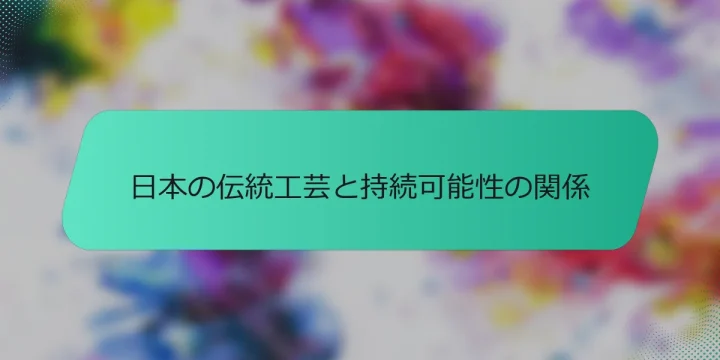
Japanese traditional crafts encompass a rich heritage of handmade techniques and cultural practices, including pottery, textiles, woodworking, and lacquerware. Each craft varies by region, employing specific materials and methods, such as the traditional Shigaraki pottery from Shiga Prefecture. These crafts are passed down through generations, reflecting cultural values and aesthetic sensibilities while emphasizing the use of sustainable materials. Sustainability, which focuses on meeting present needs without compromising future generations, is integral to Japanese traditional crafts, promoting resource management and reducing waste. By utilizing renewable resources and fostering local community connections, these crafts contribute to environmental conservation and the revitalization of regional economies. 日本の伝統工芸とは何ですか? 日本の伝統工芸は、長い歴史を持つ手工芸の技術と文化を指します。これには、陶芸、織物、木工、漆工芸などが含まれます。伝統工芸は、地域ごとに異なる技術やスタイルが存在します。それぞれの工芸品は、特定の材料や技法を用いて作られます。例えば、信楽焼は滋賀県の伝統的な陶芸です。これらの技術は、世代を超えて受け継がれています。日本の伝統工芸は、文化的な価値や美的感覚を反映しています。また、持続可能な素材の利用が重視されています。これにより、環境への配慮がなされています。 日本の伝統工芸の特徴は何ですか? 日本の伝統工芸の特徴は、手作りであること、地域特有の材料を使用すること、そして技術の継承が挙げられます。手作りの工芸品は、職人の技術と感性が反映されています。地域特有の材料は、地元の文化や自然環境を反映しています。技術の継承は、代々続く伝統を守るために重要です。これらの特徴により、日本の伝統工芸は独自の美しさと価値を持っています。例えば、漆器や陶芸は、地域ごとの特色が強く表れています。これらの工芸品は、持続可能な資源を利用し、環境への配慮も見られます。 どのような素材が使用されていますか? 日本の伝統工芸では、主に木材、竹、和紙、陶器、織物が使用されています。木材は、家具や建築に広く用いられます。竹は、軽量で強度があるため、道具や装飾品に適しています。和紙は、手作りの技術で作られ、書道や装飾に利用されます。陶器は、土から作られ、日常用品やアートとして重宝されています。織物は、絹や綿から作られ、伝統的な衣服や装飾品に使用されます。これらの素材は、持続可能な方法で調達され、環境への負荷を最小限に抑えています。 どのような技術が必要ですか? 日本の伝統工芸には、持続可能性を支えるための特定の技術が必要です。これには、自然素材の利用や伝統的な製法が含まれます。例えば、木材や竹、和紙などの再生可能な資源を使用することが重要です。また、手作業による製造技術は、エネルギー消費を抑えます。さらに、地域の知識や技術を継承することが、持続可能な生産に寄与します。これらの技術は、環境への影響を最小限に抑えつつ、文化的価値を保持するために不可欠です。 日本の伝統工芸の歴史はどのようなものですか? 日本の伝統工芸の歴史は、古代から続く技術と文化の集積です。縄文時代から始まり、平安時代に発展しました。武士の時代には、特に陶芸や漆器が栄えました。江戸時代には、地域ごとの特色が強まりました。明治以降は、近代化の影響を受けましたが、伝統技術は守られています。現在も多くの職人が技術を継承しています。これにより、伝統工芸は文化遺産として重要視されています。 どの時代に発展しましたか? 日本の伝統工芸は主に平安時代から発展しました。平安時代(794年~1185年)には、貴族文化が栄え、工芸品の制作が盛んになりました。特に、漆器や織物が高度に発展しました。鎌倉時代(1185年~1333年)には、武士階級の影響を受けて新たな工芸スタイルが生まれました。江戸時代(1603年~1868年)には、商業の発展に伴い、様々な地域特有の工芸が栄えました。これらの時代を通じて、日本の伝統工芸は技術と美意識の融合を深めていきました。 どの地域で特に有名ですか? 日本の伝統工芸は、特に京都、金沢、飛騨高山で有名です。京都は、伝統的な染色や陶芸が盛んです。金沢では、金箔や加賀友禅が名高いです。飛騨高山は、木工技術が評価されています。これらの地域は、伝統工芸の技術と文化が受け継がれています。 日本の伝統工芸はどのように製造されますか? 日本の伝統工芸は、熟練した職人によって手作業で製造されます。まず、素材の選定が行われます。木材、陶器、織物など、地域に特有の素材が使われます。次に、職人は伝統的な技法を用いて加工を始めます。例えば、陶器の場合、土を成形して焼成します。織物では、糸を染めて織り上げる工程があります。製造過程では、何世代にもわたる技術が受け継がれています。これにより、品質と美しさが保証されます。日本の伝統工芸は、地域の文化や歴史を反映しています。 製造プロセスはどのようなものですか? 製造プロセスは、伝統的な技術と現代の手法を組み合わせたものです。まず、原材料の選定が行われます。これには、地元の素材を使用することが多いです。次に、職人が手作業で加工を始めます。この過程では、何世代にもわたる技術が活かされます。さらに、製品の仕上げには細心の注意が払われます。最後に、品質検査を経て製品が完成します。このプロセスは、持続可能性を考慮しながら行われます。例えば、環境に優しい材料の使用が推奨されます。日本の伝統工芸では、こうした製造プロセスが重要な役割を果たしています。 どのように職人が技術を継承しますか? 職人は技術を弟子に直接指導することで継承します。具体的には、実践を通じて技術を学ぶことが重要です。職人は長年の経験を基に、手本を示しながら教えます。弟子は観察し、模倣することで技術を習得します。また、職人は技術の背景や理念も伝えます。これにより、技術だけでなく文化や価値観も受け継がれます。日本の伝統工芸では、この継承が世代を超えて行われています。 持続可能性とは何ですか? 持続可能性とは、環境、社会、経済において持続的な発展を目指す概念です。これは、現在のニーズを満たしつつ、将来の世代のニーズを損なわないことを重視します。持続可能な方法で資源を管理し、無駄を減らすことが求められます。例えば、再生可能エネルギーの利用や、リサイクルの促進が含まれます。持続可能性は、気候変動の緩和や生物多様性の保護にも寄与します。日本の伝統工芸は、持続可能な資源の使用や地域社会とのつながりを重視しています。これにより、持続可能性の実現に貢献しています。 持続可能性の基本的な概念は何ですか? 持続可能性の基本的な概念は、現在のニーズを満たすことが将来の世代のニーズを損なわない方法で行うことです。これは環境、経済、社会の三つの側面から成り立っています。環境面では、資源の保護と生態系の維持が重要です。経済面では、持続可能な成長を目指し、効率的な資源利用が求められます。社会面では、すべての人々が公平に恩恵を受けることが必要です。持続可能性は、国連の持続可能な開発目標(SDGs)にも反映されています。これにより、持続可能性の概念は国際的に認識されています。 環境への影響はどのように評価されますか? 環境への影響はライフサイクルアセスメント(LCA)によって評価されます。LCAは製品の全過程を分析します。原材料の採取から製造、使用、廃棄までを含みます。具体的には、資源消費や温室効果ガスの排出量が測定されます。これにより、環境への負荷を定量化できます。日本の伝統工芸では、持続可能な資源の利用が評価されます。伝統的な技法は、環境に優しい材料を使用することが多いです。これにより、持続可能性が高まります。データは環境省の報告書に基づいています。 持続可能な実践とは何ですか? 持続可能な実践とは、環境、社会、経済のバランスを考慮した活動や方法を指します。これらの実践は、資源の持続的な利用を促進し、将来の世代に対する影響を最小限に抑えることを目的としています。例えば、再生可能エネルギーの利用や廃棄物のリサイクルが含まれます。持続可能な実践は、地球温暖化の防止や生物多様性の保全にも寄与します。日本の伝統工芸においても、持続可能な素材の使用や地域社会との連携が重要です。これにより、伝統技術が次世代に引き継がれ、文化が保存されます。…
